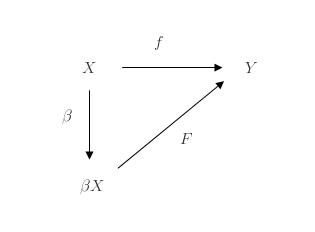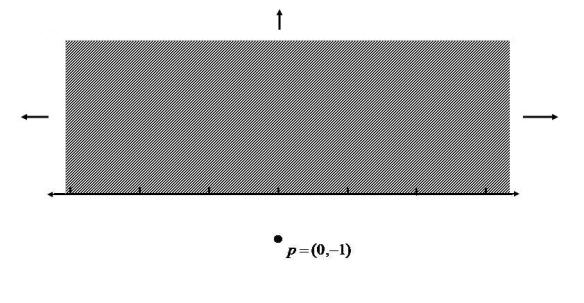Let be a completely regular space. Let
be the Stone-Cech compactification of
. In a previous post, we show that among all compactifcations of
, the Stone-Cech compactification
is maximal with respect to a partial order
(see Theorem C2 in Two Characterizations of Stone-Cech Compactification). As a result of the maximality,
is the largest among all compactifications of
both in terms of cardinality and weight. We also establish an upper bound for the cardinality of
and an upper bound for the weight of
. As a result, we have upper bounds for cardinalities and weights for all compactifications of
. We prove the following points.
.
.
- For every compactification
of the space
,
.
- For every compactification
of the space
,
.
- For every compactification
of the space
,
.
- For every compactification
of the space
,
.
Upper Bounds for Stone-Cech Compactification
Stone-Cech Compactification is Maximal
Upper Bounds for all Compactifications
It is clear that Results 5 and 6 follow from the preceding results. The links for other posts on Stone-Cech compactification can be found toward the end of this post
___________________________________________________________________________________
Some Cardinal Functions
Let be a space. The density of
is denoted by
and is defined to be the smallest cardinality of a dense set in
. For example, if
is separable, then
. The weight of the space
is denoted by
and is defined to be the smallest cardinality of a base of the space
. For example, if
is second countable (i.e. having a countable space), then
. Both
and
are cardinal functions that are commonly used in topological discussion. Most authors require that cardinal functions only take on infinite cardinals. We also adopt this convention here. We use
to denote the cardinality of the continuum (the cardinality of the real line
).
If is a cardinal number, then
refers to the cardinal number that is the cardinallity of the set of all functions from
to
. Equivalently,
is also the cardinality of the power set of
(i.e. the set of all subsets of
). If
(the first infinite ordinal), then
is the cardinality of the continuum.
If is separable, then
(as noted above) and we have
and
. Result 5 and Result 6 imply that
is an upper bound for the cardinality of all compactifications of any separable space
and
is an upper bound of the weight of all compactifications of any separable space
.
In general, Result 5 and Result 6 indicate that the density of bounds the cardinality of any compactification of
by two exponents and the density of
bounds the weight of any compactification of
by one exponent.
Another cardinal function related to weight is that of the network weight. A collection of subsets of the space
is said to be a network for
if for each point
and for each open subset
of
with
, there is some set
with
. Note that sets in a network do not have to be open. However, any base for a topology is a network. The network weight of the space
is denoted by
and is defined to be the least cardinality of a network for
. Since any base is a network, we have
. It is also clear that
for any space
. Our interest in network and network weight is to facilitate the discussion of Lemma 2 below. It is a well known fact that in a compact space, the weight and the network weight are the same (see Result 5 in Spaces With Countable Network).
___________________________________________________________________________________
Some Basic Facts
We need the following two basic results.
-
Lemma 1
Let
-
Lemma 2
Let
Proof of Lemma 1
Let be a dense set with
. Let
be the set of all functions from
to
. Consider the map
by
. This is a one-to-one map since
whenever
and
agree on a dense set. Thus we have
. Upon doing some cardinal arithmetic, we have
. Thus Lemma 1 is established.
Proof of Lemma 2
Let be a continuous function from
onto
. Let
be a base for
such that
. Let
be the set of all
where
. Note that
is a network for
(since
is a continuous function). So we have
. Since
is compact,
(see Result 5 in Spaces With Countable Network). Thus we have
.
___________________________________________________________________________________
Results 1 and 2
Let be a completely regular space. Let
be the unit interval
. We show that the Stone-Cech compactification
can be regarded as a subspace of the product space
where
(the product of
many copies of
). The cardinality of
is
, thus leading to Result 1.
Let be the set of all continuous functions
. The Stone-Cech compactification
is constructed by embedding
into the product space
where each
(see Embedding Completely Regular Spaces into a Cube or A Beginning Look at Stone-Cech Compactification). Thus
is a subspace of
where
.
Note that . Thus
can be regarded as a subspace of
where
. By Lemma 1,
can be regarded as a subspace of the product space
where
.
To see Result 2, note that the weight of where
is
. Then
, as a subspace of the product space, must have weight
.
___________________________________________________________________________________
Results 3 and 4
What drives Result 3 and Result 4 is the following theorem (established in Two Characterizations of Stone-Cech Compactification).
-
Theorem C2
Let
To define the partial order, for and
, both compactifications of
, we say that
if there is a continuous function
such that
. See the following figure.
Figure 1

In this post, we use to denote this partial order as well as the order for cardinal numbers. Thus we need to rely on context to distinguish this partial order from the order for cardinal numbers.
Let be a compactification of
. Theorem C2 indicates that
(partial order), which means that there is a continuous
such that
(the same point in
is mapped to itself by
). Note that
is the image of
under the function
. Thus we have
(cardinal number order). Thus Result 3 is established.
By Lemma 2, the existence of the continuous function implies that
(cardinal number order). Thus Result 4 is established.
___________________________________________________________________________________
Blog Posts on Stone-Cech Compactification
-
Post #0: Embedding Completely Regular Spaces into a Cube
Post #1: A Beginning Look at Stone-Cech Compactification
Post #2: Two Characterizations of Stone-Cech Compactification
Post #3: C*-Embedding Property and Stone-Cech Compactification
Post #4 (this post): Stone-Cech Compactification is Maximal
Post #5: Stone-Cech Compactification of the Integers – Basic Facts
Post #6: Stone-Cech Compactifications – Another Two Characterizations
___________________________________________________________________________________
Reference
- Engelking, R., General Topology, Revised and Completed edition, Heldermann Verlag, Berlin, 1989.
- Willard, S., General Topology, Addison-Wesley Publishing Company, 1970.
___________________________________________________________________________________







